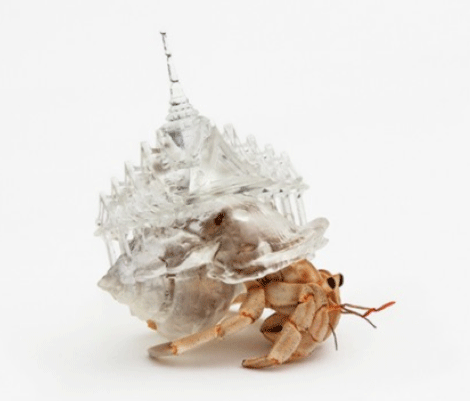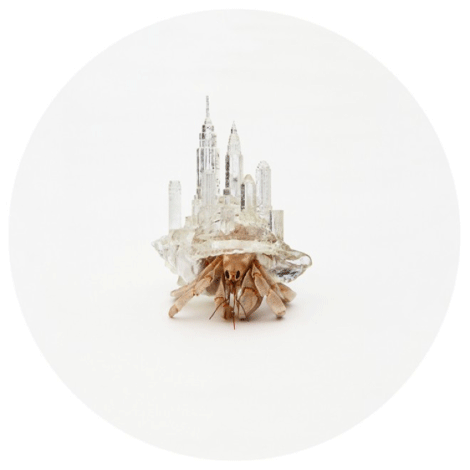
Hermit Crabs, like footballers’ wives and the American waistline, ‘do not downsize’, and just like the former, they aren’t looking for style or grace: if it’s bigger, they’ll take it.
This does not sit well with an artist, and so, Tokyo born Aki Inomata took it upon herself to add a touch of 3D printed flair to these crabby crustaceans.
“At first I thought hermit crabs could fit into any shape of shelter, since I knew that some hermit crabs choose lids of mineral water bottles,” says Aki. “However, it wasn’t so at all.
“I tried several but they didn’t pay attention.”

The Windmills of the Zaanse Schans – it’s one way to make a fashion statement
Coming to the realisation that only the real thing would do, she employed a CT scanner to extract the tomography of a hermits former home.
Using this data, Aki gradually up-scaled the virtual shells and 3D printed them in SLA Clear Resin, producing beautifully crystalline homes for her eager tenants.
From Paris to Bangkok, each hermit crab represented a different nationality by carrying an architectural cornucopia upon its back. The Windmills of the Zaanse Schans, the iconic Manhattan skyline and the steps of Santorini; all forming an integral part of the hermits adopted ‘designer’ shell.
The inspiration to create such nationally identifiable creations arose with an identity crisis back in Aki’s home soil of Japan, literally.
The land beneath the French embassy (and like all lands in the grounds of a national embassy) rightfully belong to the nation that’s represented by that embassy.
For various reasons, the Japanese and French governments struck an agreement that states every half century, this land would change sovereignty between the two. Aki was struck by this concept that land, ownership and ultimately, national identity, could so easily be revoked and re-instated.
So what, if anything, defines your nationality?
“The hermit crabs wearing the shelters I built for them, which imitate the architecture of various countries, appeared to be crossing various national borders,” says a wistful Aki. “Though the body of the hermit crab is the same, according to the shell it is wearing, its appearance changes completely.
“It’s as if they were asking, “Who are you?”. Whether it is acquiring a new nationality, immigrating, or relocating, I worked on this project with a notion of whether we can really choose the place or country to live.”

I’m sure these same transcendental crises of introspection aren’t running through the minds of the newly pimped hermit crabs, but thanks to 3D printing and scanning methods, these crustaceans are (seemingly happily) using man-made homes.
Aki isn’t the only one though who’s spared a thought for these creatures. ‘Project Shelter’ run by Makerbot, urges designers to come up with innovative, quirky and eco-friendly replacement shells that could be 3D printed and given to domestic hermit crabs to help save the oceans supply of natural habitable shells.
Pet hermit crab owners are being urged to trial these printed shells with some of their pets even being given their own facebook page; just don’t expect a friend request from Sh-elton John or Kim Kar-shell-ian anytime soon.
Why Not Hand Over a “Shelter” to Hermit Crabs? digest ver. from Aki Inomata on Vimeo.






